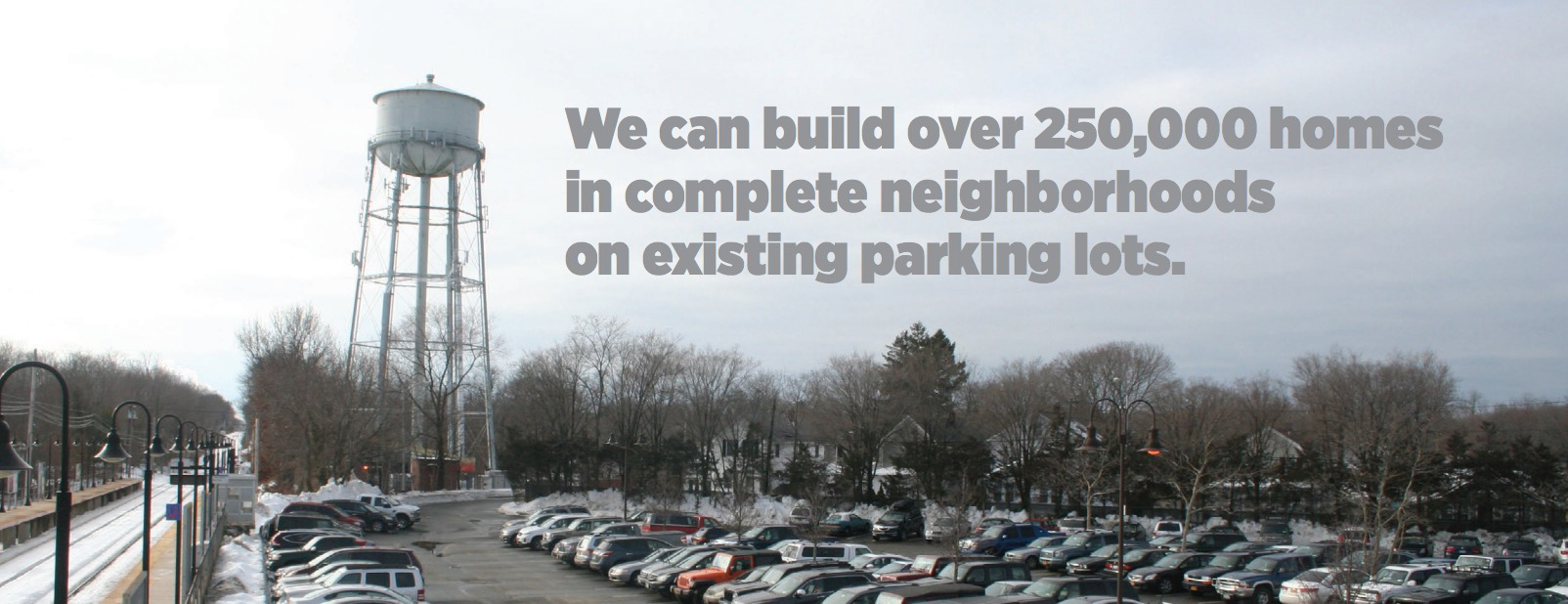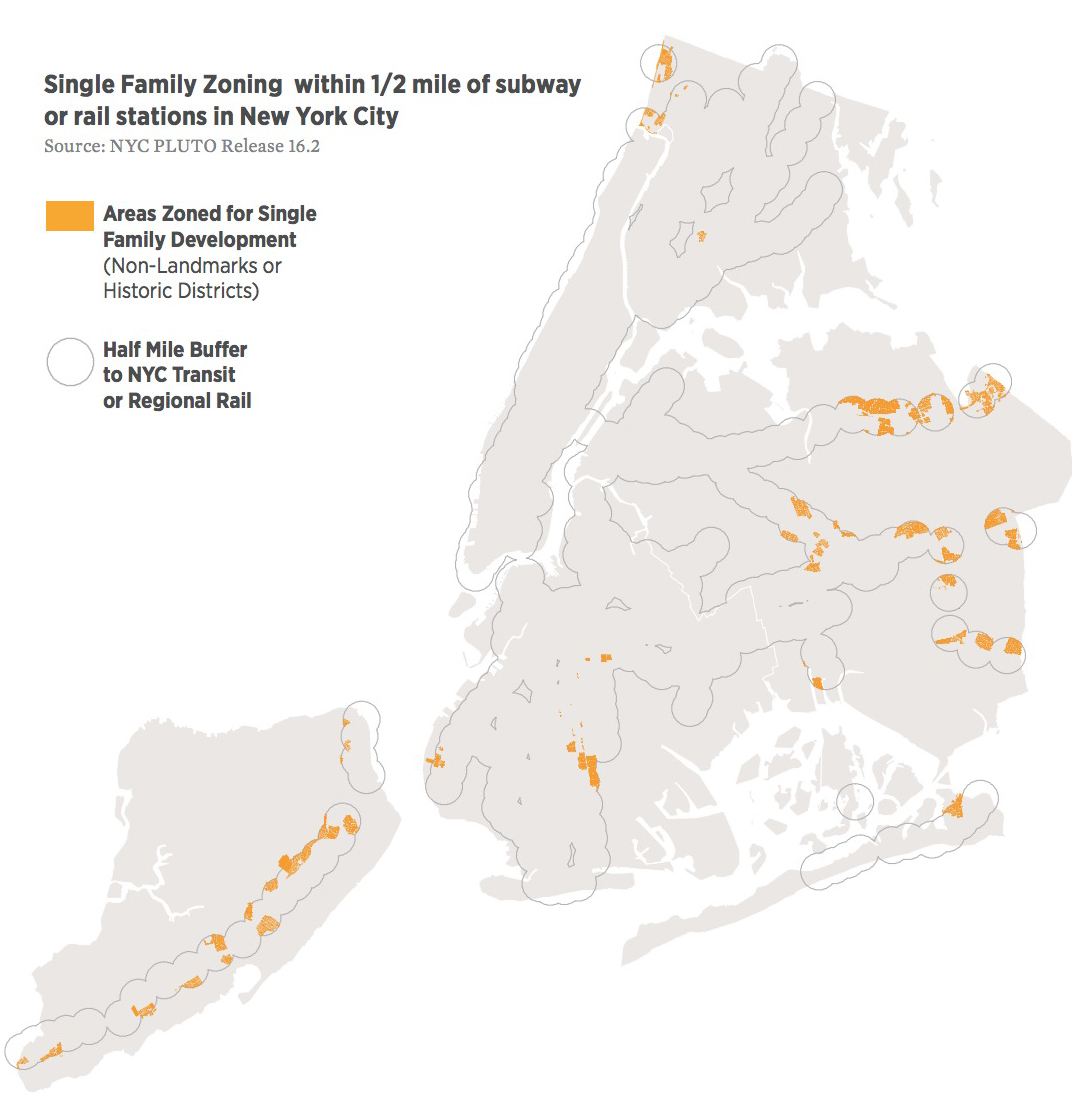REGIONAL PLAN ASSOCIATION (RPA)
Executive Summary
Two of the most commonly heard concerns in our region are that traffic is unbearable and homes are too expensive to buy or rent.
The answer to these two problems seems simple: build neighborhoods with less expensive homes where cars are needed less. The types of development that produce these kinds of neighborhoods is generally known as Transit-Oriented Development – or TOD. TOD can encompass many types of buildings – ranging from neighborhood developments like townhomes and garden apartments, to small but bustling village downtowns, to major job and economic centers. What they have in common is proximity to transit, a pedestrian-oriented nature, and the density needed to support the economy and community that are necessary for healthy and livable neighborhoods.
There are several success stories from across our region where municipalities have embraced this approach and thrived, but as our research finds, there are also far too many obstacles that prohibit or make TOD too difficult to build.
The main obstacle is simple, local, and solvable – change zoning to allow for the creation of new homes and walkable neighborhoods. A significant number of municipalities today don’t allow for good TOD or even prohibit multifamily development completely, especially in whiter and wealthier suburbs. And even in the ones where vision is in place for better transit-oriented development, some still don’t have the underlying zoning rules to make it happen.
This obstacle not only affects individuals, it affects entire communities. The suburbs were once places where working people could strike out on their own, buy a home, easily get to jobs, move up the economic ladder, and contribute to the local economy and community, but that has vanished as competition for housing has grown and prices have skyrocketed. When younger families don’t have the opportunity buy an affordable starter home and build equity, empty nesters have nobody to sell their homes to when they want to downsize or move. When people who make a more modest living don’t have housing opportunities, their jobs – and the community and economy that they build – go elsewhere. When there is not enough affordable rental housing, especially in walkable and vibrant neighborhoods, younger residents leave for the places that do, or stay at home for increasing longer periods of time. In New Jersey, 47 percent of 18-to-34-year-olds were still living with their parents in 2015, the highest rate in the country.
Without new affordable homes and walkable neighborhoods, housing markets tighten and costs rise, leading to less disposable income, longer commutes, the need to work longer hours, more stress, and poorer health for the region’s households. This disparity falls most heavily on the region’s lower-income households who, as referenced in RPA’s report Pushed Out, have seen housing costs rise unabated and continue to get pushed further away from central, walkable areas with access to jobs2. But it affects others as well – young families, seniors and anyone who needs affordable housing and doesn’t want to or can’t spend hours a day behind the wheel.
People want these homes and neighborhoods, and we can build them if we choose to. Walkable neighborhoods with good access to transit are increasingly valued, by younger residents of the region in particular. Good, contextual transit-oriented development does more than just build homes. It supports the economy with shops, restaurants, jobs, and community facilities, all within walking distance. These don’t just serve the new development, but benefit the surrounding area as well.
The merits of TOD are many: improved mobility, reduced environmental impact, economic development, and quality urban design all make for highly desirable places to live and work. But these benefits are not necessarily shared equally. In order to build TOD that will contribute to equity and prosperity for all, policymakers and developers must not only put in place the policies to ensure its construction, but also policies which ensure that these new homes are available to wide range of people with a diversity of incomes, professions, and family sizes.
This report looks at a number of opportunities to create more TOD in our region and to increase the number of homes and vibrant, walkable neighborhoods for people at all income levels. We first examine current conditions, where we have opportunities to put in place better policies that would enable TOD in the first place. We then explore future opportunities and the potential that will be unlocked in a world of on-demand, shared and autonomous vehicles where we no longer need vast expanses of parking near train stations. And finally we assess the state of affordability requirements for multifamily developments and suggest complementary policies to ensure that affordable housing increases as we expand overall supply.
Main Findings
Local zoning continues to be a major impediment to Transit-Oriented Development.
Today less than half of the rail stations RPA examined with the infrastructure to support good TOD (124 out of 264) currently have land use regulations to support it3. Most either allow only limited multi-family development or none at all.
Municipalities which do not allow transit-oriented development are significantly whiter and wealthier than average.
even after accounting for the fact that more affluent communities tend to be in lower-density areas further from Manhattan and its job base. While access to jobs and the region’s core does make a difference in how friendly a municipality is to TOD, it is less than expected and not as much of a factor as the demographic makeup of the municipality.
There are dozens of places in the region which have significant regional connectivity and job opportunities, but prohibit the homes people need to take advantage of them.
20% of the total rail stations outside of New York City with access to 200,000 jobs or more only allow for low-density, single family development. And in New York City there are over 6 square miles of land within walking distance of transit where multifamily housing is prohibited.
New technology opens up big opportunities. RPA’s recent research shows that it is likely that within 20 to 30 years the vast majority of auto trips in the region will be made in on-demand, shared and autonomous vehicles (AVs).
Since AVs will not need to sit idle in parking lots, much of the surface parking near rail stations will likely become disused, potentially blighting village centers. Instead of letting this happen, we can build well over 250,000 new homes in complete neighborhoods with enough shops, offices, community centers, parks and schools that will support this growth, and the surrounding communities as well.
Recommendations
Allow for and encourage mixed-used development in proximity to all train stations, especially on sites currently used for parking.
By proactively zoning for multifamily, mixed-use development near rail stations, we can create the walkable, transit-oriented communities that are in demand today and needed for the future. While this is primarily the responsibility of the region’s 782 municipalities, states should provide planning assistance to encourage municipalities to allow more multifamily and mixed-use development near stations.
Coordinate infrastructure with growth.
Getting the infrastructure necessary to support TOD can be difficult, even in places which embrace it. And communities which do have this infrastructure in place often don’t allow for the development it can support. Planning grants and technical assistance should be provided to assist municipalities, and state infrastructure funding should be contingent on municipalities enacting zoning to allow multifamily housing in appropriate locations. New Jersey’s Transit Village Program provides a template for how to coordinate state investment and assistance with TOD.
Reform federal financing mechanisms to allow for easier mixed-use development. Federal insurance and financing programs through the Department of Housing and Urban Development, the Federal Housing Administration, Fannie Mae and Freddie Mac are used in the vast majority of new housing development.
However, restrictions on the proportion of commercial space and income allowed in these developments often don’t allow for the type of two- or three-story mixed-use development common to the region’s smaller downtowns, and needed in commercial strips and near transit. Federal regulations should be changed to allow for this type of mixed-use development.
Institute inclusionary housing requirements region-wide, and a state requirement in New York that all municipalities provide affordable housing opportunities.
Two of the region’s states, Connecticut and New Jersey, require that all municipalities provide affordable housing opportunities. In order to ensure this, local zoning require ments may be overridden through court in municipalities that are not meeting these obligations if the proposed development provides affordable housing. New York State should join its neighbors and implement a similar system.
In addition, all three states should couple overall affordable housing obligations with requirements that municipalities create mixed-income communities by including affordable homes in all TOD and multifamily developments. This will ensure that low and moderate-income residents also benefit from these developments and that they do not further contribute to economic exclusion in the types of walkable communities that are increasingly desired throughout our region.
Keep and expand our transit-oriented development possibilities by investing in our suburban transit systems.
Transit oriented development can only thrive when the nearby transit is reliable and affordable. Strategies in this report rely on a commuter rail network and connecting local transit networks that are safe, well-managed, inexpensive, and adequately funded, so transit remains an attractive option. This means more funding is necessary for the MTA, NJ Transit and Connecticut Transit both to maintain existing standards and to improve service and capacity on our trains and buses.
Download full version (PDF): Untapped Potential
About the Regional Plan Association
www.rpa.org
RPA is America’s most distinguished urban research and advocacy organization. RPA works to improve the prosperity, infrastructure, sustainability and quality of life of the New York-New Jersey-Connecticut metropolitan region. Some of the region’s most significant public works, economic development and open space projects have their roots in RPA ideas and initiatives, from the location of the George Washington Bridge to the revitalization of downtown Brooklyn, Stamford and Newark to the preservation of open space and development of parks in the Palisades, Governors Island and Gateway National Recreation Area.
Tags: Connecticut, CT, New Jersey, New York, New York City, NJ, NY, NYC, Regional Plan Association, RPA, TOD, Transit-Oriented Development








 RSS Feed
RSS Feed